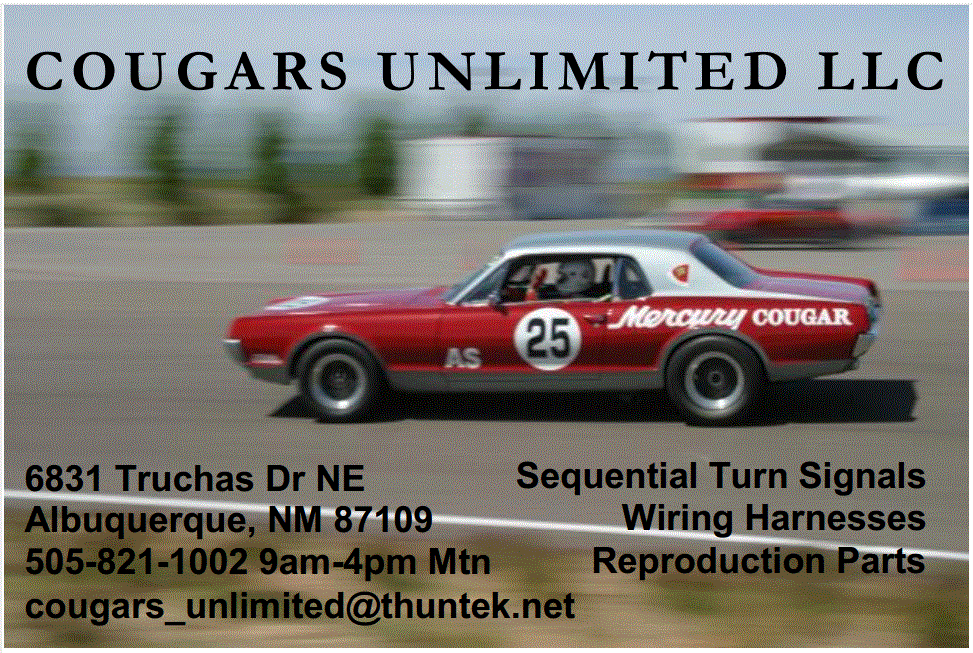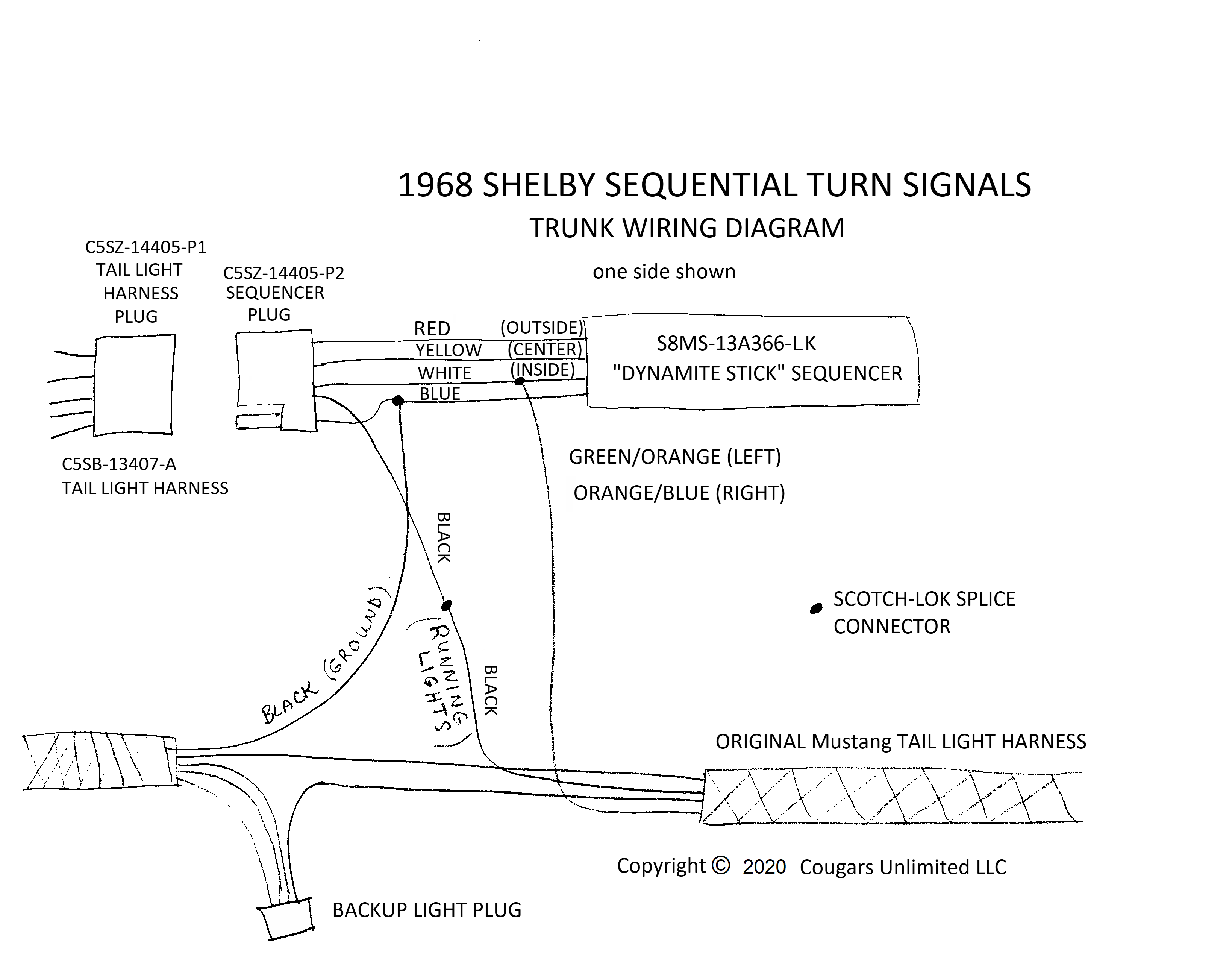

Troubleshooting 1968 Shelby Sequential Turn Signals
This article covers troubleshooting 1968 Shelby Mustang sequential turn signals.
The turn signal system has consists of parts: the turn
signal switch, (located in the steering column), a turn signal flasher,
an emergency signal flasher and two gold painted sequential controller tubes
(often called "Dynamite sticks") in the trunk behind the cardboard
covers for the tail light sockets. The most failure prone parts
are the turn signal switch, the sequential controllers, and the
turn signal flashers.
Basically, the system works as follows: when the directional lever on the turn signal switch is moved, it completes circuits that select and feed power from the flasher to the corresponding bank of rear lights. Power for the lights is fed from the turn signal flasher through the turn signal switch to the sequencer and to the inboard light on the side selected. The center and outboard tail lights are controlled by the sequencer.
When the emergency button is depressed, it completes circuits that feed power from the emergency flasher to the turn signal switch and out to both sequencers for the rear tail lights.
The brake light power is fed from the brake light switch to the turn signal switch and out to the rear tail lights. Note: this means that the brake lights are sequenced (once) each time the brake pedal is depressed.
Now that you understand a little about how your turn signal system works, you can start troubleshooting. You will need a VOM (Volt-Ohm-Meter) and the external lighting wiring diagram from the 1968 Ford Mustang shop manual. See below for the sequential wiring diagram. The most common complaints are: no turn signals, one or more lights on but not flashing, one or more lights flashing, and center and front lights only flashing. The first place to check is the turn signal fuse under the dash in the fuse box. The next stop is to check all bulbs, their sockets, and grounds. The Shelby Mustang is very sensitive to poor tail light bezel grounding. If these are all good, then now the real sleuthing must begin!

No turn signals (right or left):
When the turn signal lever is depressed, no lights come on anywhere. First
check the turn signal fuse in the fuse box.
Next, check the turn signal flasher under the dash. Try swapping the emergency flasher with the
turn signal flasher to verify operation. Replace with a D0WY-13350-AR5 (for 1157 bulbs) flasher if necessary.
Then try depressing the emergency switch, if the emergency flashers work,
the turn signal switch is most likely bad. Disconnect the turn signal switch from the harness
and check it according to Table 1 using a VOM or self powered test light. The table shows wire pairs that
should be shorted together with the switch in the indicated position. If any connections are open,
replace the switch. Usually the switch has failed when the plastic around the riveted contacts
in the area around the emergency button appears to be burnt or melted. This can only be seen
with the steering wheel removed. The turn signal switch connector pins can also be burnt or
oxidized: carefully inspect the pins on both sides of the connector. Make sure they are all
securely seated into the connector and the connector is not melted or burned. For more information, review the
Turn Signal Switch Diagnosis Guide at www.cougarsunlimited.net.
CENTER POSITION |
LEFT TURN |
RIGHT TURN |
| Green, Orange-Blue | Blue, Green-White | Blue, Orange-Blue |
| Green, Green-Orange | Blue, Green-Orange | Blue, White-Blue |
| Blue, Red | Blue, Red | Blue, Red |
| Green, Orange-Blue | Green, Green-Orange |
Table 1. 1968 Turn signal switch connections
When replacing the turn signal switch, make sure the connections follow the diagram in the 1968 Mustang Shop Manual.No left turn signal:
With the turn signal lever pushed down, using a test light, check for 12V flashing power on the green/orange wire at the turn signal switch connector and then all the connections feeding the left side sequencer in the trunk. If there is power, verify that the Scotch-Lok connector is crimped tight and is not oxidized. Replace if necessary. If there is no power on the green/orange wire, the turn signal switch may be bad.No left front turn signal:
With the turn signal lever pushed down, check for 12V flashing power on the green/white wire on both sides of the turn signal switch connector and then check at every connection point feeding the left front turn signal light. If there is no power on the green/white wire, the turn signal switch may be bad.No right turn signal:
With the turn signal lever pushed up, check for 12V flashing power on the orange/blue wire on both sides of the turn signal switch connector and then all the connections feeding the right side sequencer in the trunk. If there is power, verify that the Scotch-Lok connector is crimped tight and is not oxidized. Replace if necessary. If there is no power on orange/blue wire, the turn signal switch may be bad.No right front turn signal:
With the turn signal lever pushed up, check for 12V flashing power on the white/blue on both sides of the turn signal switch connector and then check at every connection point feeding the right front turn signal light. If there is no power on white/blue wire, the turn signal switch may be bad.Either outer rear light not flashing or outer light flashing dimly - flasher cycling too fast
First, check the to make sure that bulbs, sockets, Scotch-Lok connections, and grounds are OK. If so, the trouble is most likely that flasher is cycling too fast (greater than 55 flashes per minute). This can be caused by the using the incorrect flasher (most likely a 552). Another problem is when high wiring resistance between the battery and the flasher causes a voltage drop that tricks the electronic flasher to restart prematurely. This problem can be caused by the ammeter wire resistance (greater than .1 ohms). Replace the flasher with a D0WY-13350-AR5.
One or more center or outer rear lights flashing together:
If all bulbs, sockets, Scotch-Lok connections, and grounds are OK, the trouble is most likely that one of the components in the sequencer has failed and the sequencer must be replaced.
One or more of the center or outer rear lights not flashing:
If all bulbs, sockets, Scotch-Lok connections, and grounds are OK, the trouble is most likely that one of the components in the sequencer has failed and the sequencer must be replaced.
No brake lights:
First check for 12V power on the green/red wire feeding the brake light switch on the brake pedal. Then check for power on the green wire when the pedal is depressed. If no power, make sure the switch wires are not broken. The 1968 disc brake cars use an extension harness, so check both ends. Replace the switch if necessary. Use only a Ford/Motorcraft power disc brake switch as the spring in aftermarket switches are too stiff and do not work easily. Next check for power on both sides of the green wire at the turn signal switch connector. These pins can become oxidized (burnt) and fail with the current drawn by the six 1157 tail light bulbs. Replace the pins as necessary. It is very common for the turn signal switch to fail at the riveted connection on top of the switch cam. This problem may be repaired with a C7SZ-13318-BR cam repair kit. Otherwise, replace the switch. For more details, review the Turn Signal Switch Diagnosis Guide at www.cougarsunlimited.net..
Dash indicator light doesn't flash:
The original Tun-Sol 420 flashers wear out with age and may have stopped flashing. Also, when LED bulbs are used, a thermal flasher will not flash because the LEDs do not draw suffient current. Replace the flasher with a D0WY-13350-AR5 flasher. (Use a D0WY-13350-L if using LEDs.) These flashers have a long duration "ON" time to allow all three bulbs to turn on completely before cycling.
Description |
1968 Shelby |
| Turn signal sequential flasher | S8MS-13A366-LK (Replaces S8MS-13A366-AK) compatible with 1157 or LED bulbs) |
| Turn signal flasher | D0WY-13350-AR5 (use D0WY-13350-L with LEDs) |
| Emergency flasher | D0WY-13350-AR5 (use D0WY-13350-L with LEDs) |
| Brake light switch | C9VY-13480-A (marked C8ZB-13480-B) |
| Brake light switch extension harness | C8ZZ-13K408-AR (marked C8ZB-13K408-A) |
Turn signal switch (w/o tilt) | C8SZ-13341-AR |
| Turn signal switch (w/tilt) | C8SZ-13341-BR |
Table 2. Service Parts list
11/04/22 SMSEQTS
© Copyright Cougars Unlimited LLC Back to Cougars Unlimited LLC Home Page